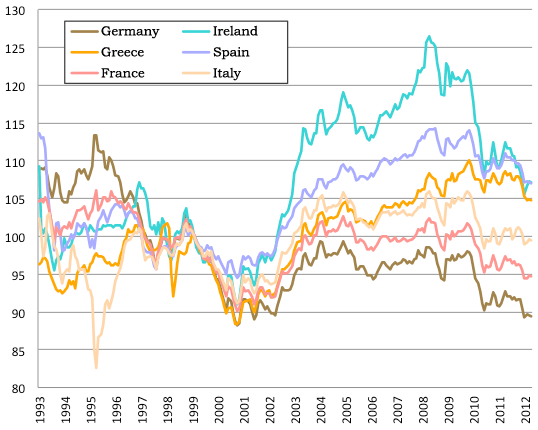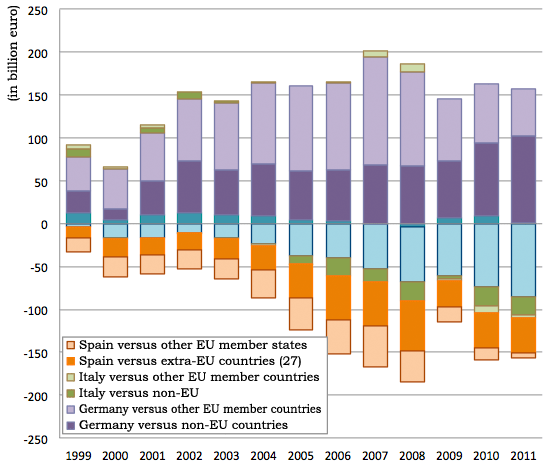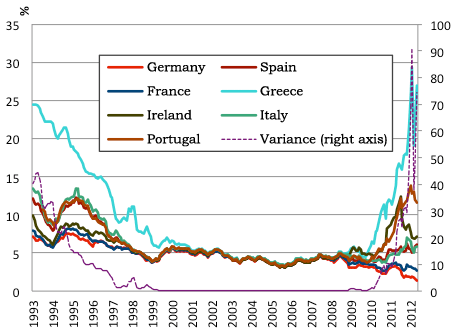Market and monetary integration
As foreigners, we feel the benefits of European integration most strongly while traveling from one country to another within the European Union (EU). In many cases within the EU, there is no need to exchange currencies or to go through customs and immigration procedures, which are usually required when crossing national borders. Indeed, traveling within the EU is practically the same as traveling within a single country.
Both the idea of removing barriers to the movement of goods and people within Europe and that of introducing a common currency were conceived in order to achieve the overarching common goal of creating a single European market. In One Market, One Money: An Evaluation of the Potential Benefits and Costs of Forming an Economic and Monetary Union, a report detailing plans for monetary integration, the European Commission advocated the necessity of monetary union, noting that the creation of a single currency is essential in order to derive the full benefits of a single European market. Monetary integration—which eliminates the costs of foreign exchange transactions and risk associated with exchange rate fluctuations—facilitates trade, producing the same effects as those achieved by eliminating trade barriers such as import tariffs and regulatory obstacles. Seen in this light, monetary integration seems to be defined reasonably as an extension of market integration.
Optimum currency area
However, while it is generally perceived that eliminating trade barriers benefits the economy as a whole, the effects of introducing a single currency are not that simple (Krugman, 1990). Countries with their own currencies have their own macroeconomic adjustment tools, namely, independent monetary and exchange rate policies, and monetary integration means losing independent control over such policies.
According to the theory of the optimum currency area that provides the criteria for evaluating the effects of introducing a common currency, a set of countries is better fit for monetary integration when the similarities of the economies, the unity of goods and labor markets, flexibility in price adjustment, and fiscal mobility across national boundaries are greater, because the need for macroeconomic adjustment will be lower. In the 1990s, when European counties began to take concrete steps toward monetary integration, some economists made strong arguments against the move. They insisted that, based on the theory of the optimum currency area, the net economic impact of adopting an EU-wide single currency would be negative (Krugman, 1990; Feldstein, 1997; etc.).
Increased economic divergences under the single currency
On the other hand, there were also expectations that any negative factors in the initial stage of monetary integration would disappear in due course if the market and monetary integration leads to the convergence of the real economies of member states. However, developments in the 10 years subsequent to the introduction of the euro show that the monetary integration has caused the divergence—not convergence—of the economies. Continued divergence in inflation rates across euro zone countries over a long period of time pushed up the real exchange rates of countries with higher inflation rates, widening disparities in export competitiveness and expanding trade and current account imbalances within the euro zone. Restoring competitiveness by nominal devaluation is not an option. Thus, in order to correct imbalances, countries with weak economies need to adjust their real exchange rates by bringing down the prices. This, however, is no easy task for these countries where productivity remains low and prices are inflexible (Feldstein, 2012).
(1Q/1999 = 100)


Furthermore, cross-border labor mobility within the EU remains limited. With member countries differing not only in language but also in social security systems, those residing in other EU member countries other than their own account for only 2.8% of the total work-age population (European Commission, 2012). The gap between the expectation that the introduction of the euro would lead to the convergence of the member economies and the reality is visible in the diverging trends in their long-term government bond yields. As shown in the line graph (Fig. 3), lines representing long-term government bond yields diverge significantly to the right like twisted strings unwinding.

While the EU proceeds with market and monetary integration, the townscapes of member countries remain as richly diverse as ever. Even between France and Belgium, which are both geographically and culturally close, one cannot cross the border without noticing changes in the hilly landscapes and the village atmosphere. No matter how it may appear that national borders are disappearing, it is not easy to overcome structural differences deeply rooted in the histories and customs of countries.


